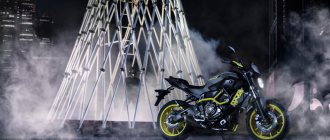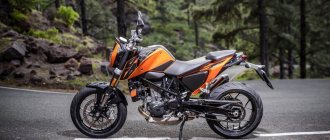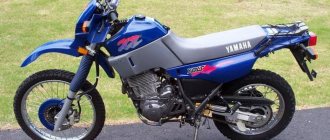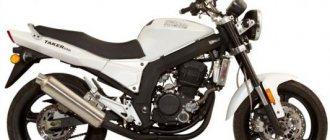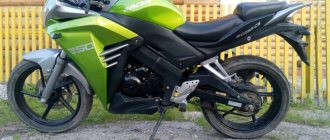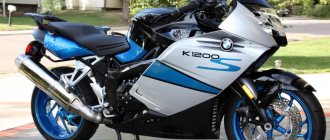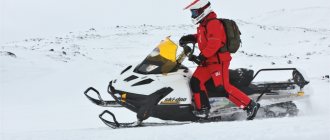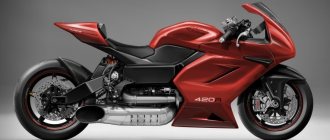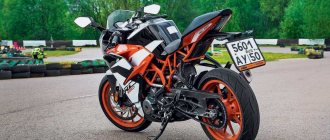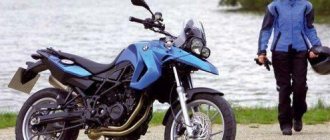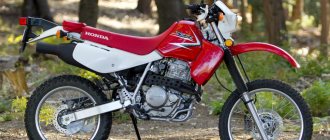About the engine
The K is equipped with an LC4 type power unit, which experts and enthusiasts rightly classify as an “off-road icon.” Among modern analogues, this engine is the only one that, having one cylinder, has great power, quite suitable for real competitions, and not just road trips. The maximum potential of the engine is so great that only the most experienced riders can fully master it.
The bike in question was created in 1980. It was released in bright orange and was originally intended to participate in the European Motocross Championship, which soon became a world championship among two-wheeled units equipped with 4T engines with a volume of more than 500 cubic centimeters.
Especially for this category of motorcycles, the Austrian company Rotax assembled an engine that is used by many manufacturers of motocross motorcycles. With such a power unit, Austrian bikes have repeatedly become winners of various competitions. However, in the late 80s of the last century, KTM designers developed their own single-cylinder LC4 engine.
MY MOTORCYCLE
The KTM 690 ENDURO R'12 is the only motorcycle in its genre. It is designed as a lightweight sports enduro, but is equipped with a powerful engine suitable for highway use and even off-road touring.
First, a little about the LC4 engine - an off-road icon. Today it is the only 1-cylinder engine in its genre - incredibly powerful, suitable for enduro competitions, not relaxed off-road touring. Only experienced riders can use its potential to the maximum.
It's hard to believe, but this motor is also suitable for tourism. The history of the big orange monocylinder began in 1980, when the regular European Championship grew into the World Motocross Championship with a new class “4T engines above 500 cm3”. The Austrian company Rotax assembled an engine especially for this category of motorcycles. It was bought by many motorcycle manufacturers such as Aprilia, SWM, Puch and finally KTM. Equipped with this engine, motorcycles of the Austrian company won many races. However, in the late 1980s, KTM decided to develop a 1-cylinder unit on its own. Thus the LC4 (an abbreviation for liquid-cooled 4-stroke) was born.
Evolution of the LC4 Initially, only the 550 cc racing model was available, with 45 hp. on the rear wheel, good torque and very noticeable vibrations. Motor for real men!
The evolution of the LC4 has been rapid. Five versions were immediately released: a sports enduro, an all-terrain tourer (basic and Adventure versions), a rally prototype that won five Dakar rallies, and a supermotard. In 2006, the 660 cc LC4 Rally was replaced by a 690 cc. Based on this powerful engine, a new motorcycle was built with a trellis frame and various interesting solutions such as a plastic tank in the tail. Rule changes in the Dakar Rally forced this sports prototype into premature retirement. Off-road enthusiasts were eagerly waiting for KTM to release a civilian version of the motorcycle, the new mid-sized Adventure, but the Austrians were in no hurry. The company introduced the 690 Enduro model in 2007: 654 cm3, 60 hp. on the crankshaft and 139 kg of dry weight. In the design of this civilian model, rally developments were used, a plastic tank serving as a subframe. The Enduro received a full set of optics, informative instrumentation, WP suspension with 250 mm travel and a linkage system at the rear, which is uncharacteristic of most off-road KTMs.
The motorcycle turned out to be impressive, but was immediately noted for three unpleasant features. All testers complained about the steering wheel's limited turn, the seat being uncomfortable for long trips, and the gas cap behind it being obscured by luggage. Definitely not an enduro-tourist, although it could become one: the motorcycle handled perfectly on winding roads - both asphalt and dirt. A year later, the R-version was released with a similar engine and frame (not counting the color), suspension travel increased to 275 mm, a more spartan headlight and instrumentation copied from the EXC sports enduro. As a result, two similar models appeared in the catalog: the “tourist” 690 Enduro, which was too spartan, and the racing 690 Enduro R, which was too heavy for a sports enduro.
1-2, The design of the headlight and the front of the motorcycle in general has become more pleasant and expressive. The headlight shines noticeably brighter
3-4. The 2012 Enduro R instrument panel has become much more readable and informative. Last season, the motorcycle was equipped with a skimpy sports panel, now the rider has a tidy system similar to the tourist 990 Adventure 5. The plastic crankcase protection is a dubious choice, but still it performs its functions. Behind the toothed step and the same toothed brake foot, you can see the master cylinder of the rear brake circuit and the line laid along the top of the pendulum. The engine is started only by an electric starter, kick is not provided even as an option.
The only version In 2012, in the model range of the Austrian company there is only one cubic enduro with the index “R”. At first glance, it seems that the base model has been retired. However, in reality we are talking about a kind of “mix” of two versions. What remained from the basic version was the headlight, tidy, and suspensions with a travel of 250 mm; from the R version - orange frame. There are also important innovations: a more comfortable seat, increased steering angle, a 690 cc engine from the 690 Duke and 66 “horses” under the crankcase cover.
The R version initially looked more impressive than the regular one, but the base version was equipped with a more powerful headlight. My heart was drawn to Erka, my mind was drawn to a standard and more boring-looking motorcycle. Now both advantages are combined in one model
.TEST DRIVE: KTM 690 ENDURO R'12
The ergonomics of this KTM are like those of a proper enduro racing car: a flat seat, a position shifted to the front wheel, high handlebars, widely spaced footpegs that extend slightly back. Thanks to the increased steering angle and comfortable seat, riding the motorcycle has become more enjoyable. At the same time, the Enduro R remains the same unique motorcycle with a live engine. Now more powerful than previous generations. The engine starts only with an electric starter and has an appetite corresponding to its 690 cc volume. In the test, which took place on the island of Sardinia on high-speed off-road sections and rocky trails, the average consumption was about 5.3 l/100 km. The motor picks up speed extremely quickly. If you confidently unscrew the throttle, your palms get tired because you have to cling to the handlebars with all your might so as not to fly out of the saddle. There is no aerodynamic protection, and the engine has a lot of “stupidity”.
At medium and high speeds, the engine lives to the fullest, emitting a cheerful and moderately loud roar from the single muffler. This proves that to run a good herd of horsepower you don’t have to stun your neighbor. However, at low speeds the engine disappoints: there is no torque pulsation typical for a large-volume engine, and at low speeds it is difficult to control the engine speed, especially on slippery roads.
Speed The Enduro R is at its best when riding on high-speed routes, when its engine produces all its 66 hp. Tight factory adjustments of the long-travel suspensions allow you to confidently take wide turns at high speed, without swaying or yawing. The motorcycle provokes aggressive riding. Aggressive, in the case of the 690 Enduro R, means fast. The character of the motorcycle is reminiscent of a cubic enduro racing bike, with the exception that there are noticeably more “horses” here.
Riders who can't control the power of the 690cc engine can have a lot of fun riding in open terrain and on well-packed dirt roads. The main thing is that there are no sharp turns or difficult trial terrain on the way, where it will be difficult for an inexperienced rider to cope with a heavy off-road motorcycle. It would be great to release a factory kit for the Enduro R that turns it into a tourist: a comfortable seat, a fairing, an enlarged tank, a trunk, frames for attaching side cases. KTM produced all this for the previous model LC4 640 Adventure. Why not produce the above accessories again? It is not surprising that some third-party companies (www.albertodottori.net. www. rally-raidproducts.co.uk. www.corbin.com') have already begun to fill the gap in the KTM lineup, offering kits for such transformations. But with such a tourist body kit, the price of this motorcycle is approaching the level of two-cylinder SUVs, which are more comfortable and practical
TTX
| Price: | 9500 euros |
| Buy: | www.ktm.ua |
| ENGINE | |
| POWER: | 66 hp at 7500 rpm |
| Torque : _ | 68 Nm at 6000 rpm |
| TYPE: | 690 cm3.1C, 4T. 4v, 0HC, liquid cooling |
| Bore x stroke : _ | 102×84.5 mm |
| Compression ratio : | 12,5:1 |
| Clutch: | multi-disc in oil bath, slipping, hydraulically driven |
| Supply system : | injector |
| Transmission: | 6-speed, chain |
| CHASSIS | |
| Frame: | Tubular chrome molybdenum, birdcage |
| Steering column angle / stem : | 277112 mm |
| Front suspension : | 48mm inverted telescopic fork, fully adjustable, 250mm travel |
| Rear: | linkage system with monoshock absorber, fully adjustable, 250 mm travel |
| Front brakes : | 300 mm disc, 2-piston caliper |
| Rear: | 240 mm disc, 1-piston caliper |
| Front tire : | 90/90 R21 |
| Rear: | 140/80 R18 |
| DIMENSIONS | |
| Wheelbase : _ | 1504 mm |
| Seat height : _ | 910 mm |
| Ground clearance : | 280 mm |
| Tank: | 12l |
| Weight without fuel : | 142 kg |
Characteristics of the KTM 690 Enduro
The main parameters of the motorcycle of the series in question:
- Power indicator - 66 liters. With.
- Speed – 7.5 thousand rotations per minute.
- Working volume – 690 cc.
- Compression – 12.5.
- Power supply – injection system.
- Cooling is liquid type.
- The transmission unit is a six-speed gearbox with a valuable drive.
- A type of frame is a tubular structure containing molybdenum and chromium.
- The front suspension is an inverted adjustable telescopic fork.
- The rear analogue is a lever block with a monoshock absorber.
- Brakes - discs with calipers.
- Wheelbase – 1.5 m.
- Seat height – 0.91 m.
- Weight – 142 kg.
- Fuel tank capacity – 12 l.
- Ground clearance – 28 cm.
post sponsor - Doc 
My experience of owning a KTM 690 Enduro 2008* (the debut year of production of this model), from 2009 to 2021, with mileage from 0 to 74645 km.
(*this model underwent a significant upgrade in 2014, this must be taken into account when reading this post and thinking about buying now))
The motorcycle was purchased new at BL in Moscow. In mid-spring 2009, only the last year's model was available, but that didn't bother me too much, I coveted this motorcycle.
By 2008, I had two Hondas in my garage: TA XL650V and XR250Baja, and lately I had been constantly dreaming of something in between - as light as a 250 and yet quite powerful. In general, my use of a motorbike is weekend rides further out of town, with the possibility of leaving the asphalt, and the same long-distance rides. On TA it was difficult for me off-road (weight, cotton suspension), but in Baja it was difficult on asphalt.
And then the KTM 690 appears: 138.5 kg dry weight and 63 horses. Moreover, this stock KTM has very cool things: WP suspension, reinforced brake lines, hydraulic clutch, thick Rental steering wheel, DID wheel rims, Brembo brakes, slipper clutch...
I had a very respectful attitude towards the KTM company - I am a fan of the Dakar Rally, and there they reigned supreme in the motorcycle class in recent years. The general opinion in our country that KTM is a piece of shit certainly affected me, but after reading reviews on the new 690s over the winter, I decided to take it.
And so in the spring of 2009, having sold TA, but leaving Baja, I became the owner of a brand new KTM 690 Enduro
I immediately bought a windshield from Duke, which improved the appearance)) and a comfortable speed of up to 100 km/h 
Even during the run-in, it became clear that the engine was very peppy. In the future, its power was always enough for me in all situations. The low weight turned out to be both a plus and a minus - off-road it’s a huge plus, but on the highway it blows away in the wind. The 690E has fabulous weight distribution because the plastic fuel tank is located at the rear. The steering is so light that it always reminded me of my old mountain bike, but the 690E doesn't have much steering angle and it takes some getting used to when spinning in tight spaces.
Its weight distribution and power plus excellent suspension constantly provoke petty hooliganism on the road. There are no obstacles either in a city traffic jam, or on a broken rural road, or on a road with no surface at all. It’s just that in the swamps and littered forests it’s still hard on it. Poking around in the dirt is not his thing. Of course, if you need to drive through some pampas, he can do it, but I personally didn’t enjoy it. After the XR250, I was used to riding at walking speed where it was necessary, but this does not work on the 690E, it requires you to rush forward. I had to learn to drive faster than I wanted. The orange teacher constantly demanded to push)) But on relatively hard surfaces it was possible to race and not worry about anything. Along with turning the throttle, a portion of the “orange drug” is instantly injected into the blood and the pleasure of driving does not let go. I often wondered how KTM managed to achieve this? What is the formula for drug 690? Weight/power + fabulous suspension + weight distribution + fantastic control (steering)... maybe something else, I don’t know.
I really liked the ergonomics right away, everything was convenient. My height is 178 cm, and the height at the seat is 910 mm, but due to the very narrow seat there were no problems with reaching the ground. The handlebars are wide and not very high relative to the seat, so you seem to be hanging over it - it was very familiar from a mountain bike. It’s comfortable to ride while standing on the pegs, and sometimes I even had to stand for half a day. But sitting on the stock seat all day is torture; when I drove 1,700 km in two days, then for a week I had no desire to get on the motorcycle. Subsequently, I always used the seat pad.
The brakes are good, but with a caveat - after all, this is an enduro motorcycle, that is, they are a little insufficient for the highway.
It’s a pleasure to work with a hydraulic clutch; after cable motorcycles, it’s just a pleasure.
Of course, there is no wind protection here; the windshield had to be additionally installed. Subsequently, I installed glass from Turatech and improved it a little - it became normal up to 130 km/h (if I’m wearing a helmet with a visor).
The mirrors give a good blurred view from the rear and are flimsy themselves - I had to replace them with thicker ones from the KTM990.
The light from the headlight is weak for night driving. It’s still possible to drive on a good road at night, but impossible on a bad one.
Protection of hands or levers, soft plastic, which can only cover the hands from the wind, has been replaced with metal protection from CYCRA.
The plastic engine protection was replaced with Turatech material, which, in addition to protection, made it possible to hang the motor with a stand-lift. There is no cigarette lighter socket - I made it myself.
The tidy shows only the essentials, without any frills.
There is no fuel level on it, only the reserve light comes on and the km countdown starts from zero, that is, you can monitor how much you have driven on reserve, but not more than 50 km. I always reset the auxiliary mileage at the gas station and roughly understood when to refuel. Before the reserve it was usually 180-200 km (12l tank)
I almost always drove on evil Pirelli MT21 tires; on the highway they didn’t allow me to go faster than 140 km/h, but on them I could easily drive off the asphalt “at random”, they were enough for 11-12 thousand km.
Wheels are 21 and 18 respectively. They turned out to be very strong - throughout the entire time there were no problems with them, the rim was never bent, not a single spoke was broken. At 60 thousand I just replaced the rim rubber bands that cover the spoke heads.
The chain and drive sprocket (original) were changed every 18-20 thousand km, the rear sprocket every 40.
Since the tank is at the back, access to the air filter is easier. The seat is removed, two bolts are unscrewed and the filter can be removed.
The standard air filter had to be replaced with a foam rubber filter, because the standard one did not fit well to the edges of the box and barely allowed dust to pass through. As a rule, once every 10 thousand km. I cleaned the foam rubber.
There is only one spark plug, not the simplest, you can’t buy it in any motorcycle store. I changed it every 15 thousand km. If you adapt, you can unscrew the spark plug without disassembling or removing anything from the motorcycle.
Liquid cooling system. There was no hassle with her, everything was standard. There is a fan on the left side of the radiator that turns on when needed and does its job. The only thing is that you need to immediately move it slightly away from the radiator, otherwise, due to vibration, it can reach the honeycombs. I don’t remember when my motor overheated.
I also immediately had to eliminate some problems from the factory, in addition to the one with the fan: replace the bolts securing the tank to the frame at the top (there were cases of broken standard bolts), protect the fuel hose on the left from chafing, disassemble and dampen the insides of the tidy.
The fuel filter is located inside the tank, and it must be changed every 10 thousand km and this procedure is very unpleasant. About the second time, I was already tired of it and the fuel filter was taken outside, replaced with another one and the fuel line was redone.
The 690 has several “drive modes” or ignition map types: stifled, standard, sport and bad gasoline. For some reason the switch is located under the seat in the back. I had to lengthen the wiring and place it on the steering wheel for easier switching. I have never tried “bad gasoline”. “Strangled” greatly reduces speed (I read somewhere that it reduces power to 37 horses), lower fuel consumption - almost always used off-road. “Standard” full power, predictability - I usually drove it, consumption is about 5l/100km. “Sport” - a very sharp response to the gas and an instant take-off, making you feel drowsy on the road.
Very quickly I had to change the standard exhaust pipe to a titanium forward flow one (Wings).
At 690, the stock is not a pipe, but a thermoreactor - they screwed a huge pipe into the lightweight enduro to meet Euro3 requirements. It seems that after I got burned for the third time, the cost of the Wings no longer seemed great to me. I also saw pictures online of a melted gas tank for 690 from the standard exhaust.
There is nothing for carrying luggage on the 690E, and even a filler neck in the tail where you usually wrap your bag. This initially scared me away from this motorcycle, until I saw all sorts of luggage accessories for it. The most interesting and high-quality ones were made by Turatech, so I had to splurge on their luggage side frames - a motorcycle is also needed for travel.
I made the luggage platform myself from a sheet of aluminum, so that it would not cover the filler neck. I also bought a special “tank bag” for the 690 from Turatech - it was used to carry tools and small items. All that remains is to figure out how to tie the luggage and at the same time have easy access to the neck. Side motorcycle bags were attached to the frames, a PIK bike bag-pants was attached to the passenger seat, behind it, immediately above the neck, was a travel mat with the ability to quickly remove it, and then a small bag on the trunk.
At the gas station, all I had to do was unfasten the mat rolled up in the case and I could fill up with gas.
Here, for convenience, I replaced the standard “turnkey” neck with a “screw cap” one.
This way I could go on long trips.
In 2009 in the Carpathians
In 2010,12,14,16 to Karelia and Khibiny
And so, on not very long trips like the Rybinsk Reservoir, etc.
On weekends I went to Oka or Klyazma or somewhere else, so I traveled to everything within a radius of 150 km from Moscow.
in the next part I will write about the engine, scheduled maintenance and breakdowns
«>
Tuning K
Initially, only a version with a 550 cc engine and 45 horsepower was developed. The engine had high torque and decent vibration. The development of LC-4 power units continued very actively. Several modifications were put into production. Among them:
- Purely sporty “Enduro”.
- Version for all-terrain touring bikes.
- A modernized version of "Adventure".
- A prototype aimed at rally racing.
In 2006, the K motorcycle received a 690 cc engine. To match the “engine” there was an improvement in other elements of the car. The equipment of the device now includes a lattice frame and a plastic fuel tank located in the tail section. Unfortunately, changes to the official rules of the Dakkar race forced said bike to leave the battlefield prematurely. Fans of this brand were eagerly awaiting the release of the new version. Despite this, manufacturers were in no hurry to present the new product.
Characteristic
The main power unit of the model is a 4-stroke gasoline engine with one cylinder. There are 4 valves per cylinder. You can start the engine using an electric starter. The motor is cooled by liquid cooling. The fuel system is based on an injector. Recommended fuel is AI-95. The engine produces 66 “horses”, while the working volume is 690 cm3.
A mechanical transmission with 6 gear levels is installed. The main gear is a metal chain. KTM 690 Enduro has the following overall dimensions: saddle height - 935 mm; base-1504 mm; Confident off-road driving is achieved due to the ground clearance of 280 mm. The fuel tank holds 12 liters.
Update
The redesigned K was introduced in 2007. Its features:
- Working volume – 654 cc.
- Power indicator - 60 liters. With.
- Dry weight – 139 kg.
- The frame configuration is “birdcage”.
- The gas tank is made of plastic.
- Updates – optics, suspension, instrument panel.
As a result, the motorbike turned out to be quite elegant and comfortable. However, there were a few unpleasant moments, judging by the reviews of the K 690:
- Most users complained about limited steering dynamics.
- The owners also noted that the saddle is uncomfortable for long trips.
- Another minus is the ill-thought-out location of the fuel tank cap, which obscures the luggage.
As a touring motorcycle, K did not succeed, although it could well have become one. Among the advantages, consumers note the excellent behavior of the car on winding dirt and asphalt roads. For variety, the designers released the R version, which had a different color scheme, a different suspension, simpler optics and dashboard.
Test drive three brothers from the KTM family: 690 Enduro, 690 CMS and 690 Duke
Reproducing objects is a trick that is possible not only for Copperfield, but also for marketers. The latter are sometimes even more skillful than the famous magician: they can not only “xerify” the source, but also endow the derivatives with special appearance features. And even character. PLATFORM.
Who would have thought: European motorcycle manufacturers are learning from the Yankees! But to what? Harley-Davidson celebrates the debut of a new model every time with pomp, although all its differences from the previous ones consist of nameplates and a couple of chrome trinkets. But the people are rejoicing! KTM has also become greedy for such exercises. In any case, this conclusion suggests itself from the content of the press releases... These thoughts wandered in my head while the heavy airbus was carrying me to the southern coast of Spain, where I was to meet a young family of medium-sized "Austrians" - the brainchild of "genetic" experiments... And it started something like this . KTM's marketers sat around the table and thought. Everyone finished their third liter of coffee. We were solving a difficult problem: how to expand the model range with minimal financial costs? Yes, not like “Harley” - adding a new letter to the index, but for real, in order to tell customers with the spontaneity of a child: “Now we have not one model, but four to choose from!” They would have sat like that until the seventh liter if the most brainy, bald guy in glasses hadn’t slammed his fist on the table and said: “It’s simple! Let's take a more or less successfully selling model, for example the KTM 690SM, and build three more on its basis. And completely different classes: from roadster to enduro.” It is not known what pleased his colleagues more - finally finding a solution or the opportunity to go home, but the company's management accepted the bald man's proposal... Now here is Spain and the test of three redheads.
| KTM 690 Enduro, Enduro Model year 2008 Engine 690 cm3 Max. power 63 hp Dry weight 138.5 kg Price not set | KTM 690 CMS, Motard Model year 2008 Engine 690 cm3 Max. power 63 hp Dry weight 139.5 kg Price not set | KTM 690 Duke, Road Model Year 2008 Engine 690 cc Max. power 65.3 hp Dry weight 148.5 kg Price not set |
ENDURO. The KTM 690 Enduro is a dual-purpose motorcycle in the truest sense of the word, that is, it is suitable for both off-road riding and traveling on public roads. Moreover, as KTM employees stated at a press conference, moving around the city on it is just as convenient as off-road. Well, well, let's see. Moreover, we had to cover part of the path to the “European Pampas” through the city and highway.
...On the “690” the pilot’s position is a little more relaxed than on the “combat” hard enduro. But it’s by no means sofa-impressive, as on typical city SUVs with the “soft” prefix, for which the curb is already an obstacle. This is the same “slight” that allows the pilot to move around the city without stress and fatigue, without leaving the saddle, without standing up on the pegs with or without a rein, as on classic hard enduros. The motorcycle is better on the track than the same “hard” ones: it is stable. And this is its most valuable advantage. Thanks to the long wheelbase, the Enduro “stands” like a glove on a straight line, the design of the chassis predetermines the neutral behavior of the bike in corners, which means it is absolutely predictable. When designing the chassis, KTM designers went their own way, as Ilyich did. It resembles the well-known, again Leninist, philosophical model of “one step forward, two steps back.” The point of the compromise is this. At a time when most of the world's leading motorcycle manufacturers advocate the use of aluminum in the manufacture of everything that is possible, and often what is not possible (these are those who have enough money: working with aluminum is an expensive pleasure), all models of the KTM 690LC4 family equipped with frames a la “birdcage” made of chrome-molybdenum alloy. But still with aluminum pendulums. We got what we wanted: we added rigidity where it was needed, and at the same time avoided the oakiness of the structure. After all, excessive rigidity of the “skeleton” negates not only the comfort of the pilot, but also endows the motorcycle with excessive “nervousness” and chronic intolerance to irregularities. You can't ride an enduro on a track! Manufacturers who rely on “lumine” are naturally aware of the dangers of excessive rigidity and, in order to achieve a compromise between obviously contradictory properties, do as much as they can. Such experiments cost a lot of money. Even bigger - the production of aluminum frames of complex configurations and with the required characteristics. And since the KTM company in terms of financial turnover is far from the players of the “big Japanese four”, its designers chose a more “budgetary” path, but by no means a losing one. The unconventional layout for enduro also makes its contribution to the motorcycle’s handling. The 690 Enduro's gas tank is located under the saddle, inside the subframe. The battery is also located there. In the usual place of the fuel container, behind the steering column, the air filter box is hidden. This gave good weight distribution along the axles and lowered the center of gravity. I kindly remembered all these nuances of the design when I was rushing along rocky off-road: here I felt the same stability as on asphalt, stability on a straight line, predictability in corners... Even a not very experienced endurist, after some time of interacting with this motorcycle, will feel a little Isn't it Everts? Tolerance to the rider’s actions is a merit of the bike’s settings: the KTM 690 Enduro generously forgives the pilot’s control errors. Not harshly - as if pacifying the driver’s agility, but easily and with pleasure: “Well, it happens...” Well, what’s there, one slipper clutch is worth it! But it also has adjustable suspension with a travel of 250 mm, a hydraulic clutch, a clearly functioning 6-speed gearbox, and the main thing that unites the three motorcycle families, which are different in purpose, is the engine. He is responsive and traction. The fuel injection system gives it what is called a balanced character. Under the “electronic” throttle, you won’t find the explosive temperament typical of carburetor vehicles, but you will find uniform thrust throughout the entire rev range. But the design was not without punctures. Everything would be fine if it were not for the universal tires - they traditionally hold up disgustingly both on the ground and on the asphalt. However, this is inevitable, and it is dictated by the fact that the bike must move on and off-road. There are much more complaints about the brakes: they also claim to be universal. However, unlike the ill-fated tires, if they work as they should on off-road, then I will not say anything similar about their effectiveness on asphalt. The two-piston front caliper (even if it’s Brembo) paired with the rear single-piston caliper is far from ideal at performing its functions in city driving. But KTM owners swore that the versatility of the motorcycle was absolute - it was equally strong both on and off the road, moreover, even the passenger footpegs were included, the mirrors, you know, were screwed on... SMC. What is the difference between motard and enduro? In the wheels, brakes? Yes, but these are secondary signs. The main difference is in the purpose. Motard is aimed at driving on asphalt - and nothing more. And don’t look at me askance - I know very well about the peculiarities of supermoto competitions, and, believe me, I’ve heard a lot about cross-country sections. But we are not talking about a racing apparatus, but about a device made in the so-called “supermoto” style. This means that it is as lanky as an enduro, but at the same time it is “shod” in small 17-inch “slippers”. And at the same time, this is still more of a street - a needle for clearing street congestion and a blow to the pride of sport bikers who are stuck in traffic jams, like blind carousers. Therefore, from the list of requirements for such a motorcycle, we have no right to exclude such an essential property for everyday use as pilot comfort. And, believe me, there is a bold tick against this word in the list of SMC advantages.
We had to test this creation of Austrian engineering in a huge parking lot with a semblance of a supermoto track marked out with ribbons. The improvised track was replete with “plug” turns, in which you can evaluate the work of the brakes at the entrance and the traction of the engine from the “bottom” at the exit. SMC excels at both! The engine and final drive settings here are the same as in the Enduro, and a test of a motard based on it once again confirmed the excellent driving characteristics of the engine. There was always enough traction reserve under the right handle: the “bottoms” helped when rolling out of 180-degree turns (and how do these motardists get through them?!), the juicy “middle” and decent “tops” helped out when exiting “fast” turns (there were a couple and such). Brakes... They worked as befits a Brembo radial 4-piston caliper with a 320 mm disc at the front and a 1-piston caliper with a 240 mm disc at the rear - that is, by the standards of the class, great! Deceleration with them is always predictable, and the sensitivity of the rear allows you to accurately “catch” the moment of locking, with the help of which motardists love to put the motorcycle into a controlled drift. A curious property lies in the suspension settings. Which of the trio of newly-minted Austrian motorcycles do you think has the longest shock absorber travel? Enduro? But they didn’t guess right! SMC! The Enduro has a suspension travel of 250 mm, while the Motard has as much as 275 and 265 mm, respectively! KTM employees explained such a non-standard priority with the desire to equalize the height of the SMC saddle with the Enduro, because if the motard were equipped with shorter-travel suspensions, and even “standing” on its 17-inch wheels, it would hardly be taller in height than a garden bench, and so it seems not even anything. A complete motorcycle! I’ll make a reservation right away that the full set of adjustments that are provided to both the front fork and the rear shock absorber negates the hypothetically negative impact of long shock absorber travel on handling. The motorcycle takes turns amazingly, and on a straight line it “stands” like a glove. The strengths of the chassis, which I noticed during the enduro test, on the SMC, being in the “correct” asphalt frame, gained even greater strength. DUKE. Strange motorcycle. Despite the fact that it is built on the basis of the KTM 690SM, which has already become somewhat widespread in our country, and being structurally similar to the two other new motorcycles of the family, it is positioned as a street motorcycle. And from an assertive, judging by its appearance, and stuffed, traditionally for KTM, with “tasty” branded components of a “street hooligan”, you always expect more than from a motard or, especially, an enduro...
That's not quite the case with Duke.
Not even that at all. Everything about him speaks of the uncontrollability of a young, albeit still inexperienced, but trained and confident fighter. The chopped edges of the orange or white cladding contrast with inserts made of black unpainted plastic. An alien-looking “muzzle” with two round headlight lenses located one above the other. A gigantic (hello to environmentalists!) suspended under the belly front muffler is framed by a plastic... The appearance instantly sets the mood for decisive action against city traffic. Unfortunately for us and fortunately for the Spaniards, we did not encounter a single real traffic jam within a radius of 150 test kilometers. But I had the opportunity to test the device in the extreme conditions of a mountain serpentine with all its delights - such as the complete absence of bump stops, a bunch of “blind” turns with elevation changes, gravel on the asphalt and trucks “growing” from behind the ledge. But about the design - it is a mixture of classics and originality. The gas tank is in the usual place, in front of the seat, and the air filter is in the depths of the rear subframe. The heavy can is hidden under the belly for a reason - to lower the center of gravity. When I saw how low it hung, I thought: how many trips over our curbs will it withstand? One? Two?.. The great thing about this bike is the way it corners. “Upside-down” WP with the same feathers as the rest of the family models, an impressive diameter (48 mm), but with a normal, “asphalt” stroke of 140 mm. The design of the pendulum, which is rigid even in appearance, resembles the boom of a tower crane. All this gives the street almost sportbike-like handling. Lightweight and admittedly beautiful Marchesini wheels minimize unsprung weight. The brakes are the same as the SMC, but, unlike it, the front one has a radial master cylinder. Its introduction into the design sharpened the reactions of the front brake and, of course, added “decisiveness” to decelerations. The rear one is the same as that of SMC and Enduro, but behaves differently: it is more “wobbly”, like on most road bikes: the weight distribution and suspension settings are different from those of a motard. ...Ugh, the serpentines are left behind. Directly ahead is a small seaside town, through the crooked streets of which we had to get to the hotel. Having entered the city, I had to maneuver between cars. How great it handles!.. Crossroads... Wow - even some kind of traffic jam! Five cars were waiting for the green light at the traffic light. By local standards, it’s already a traffic jam. I squeezed between them and got to the stop line. Here's the "green" one. .. First, second, third... Something is wrong... Bingo! I finally understood what had been gnawing at me all the way: I couldn’t understand what the motorcycle was missing. Engine! Up to 3000 rpm it twitches tensely and requires more gas, and from 5500 the whole bike and the pilot along with it are overwhelmed by a nasty small vibration. In total, a comfortable operating range is only 2500 rpm! Not much... But the red zone starts only at 8000, and maximum power (and the Duke has more power than SMC and Enduro - 65.3 hp) is achieved only at 7500 rpm... Later, when we got there, I figured it out : it’s all about the driven star of the main gear: it has two “teeth” less than the same motard. As the designers explained, they did this deliberately - in order to lower the operating speed range of the engine in each gear, and therefore the volume of exhaust already purified - nowhere else - by the catalyst. Oh, these environmentalists! So many “horses” are killed in engines! And yet, no matter how much you change the sprockets, this motorcycle will always lack an engine. Not because the engine is bad, but because everything else is much better in comparison. Both the rigid chassis and boldness in appearance set the mood for dynamic driving with sharp, intense acceleration and braking to the floor. With deceleration, the Duke is fine, but with acceleration... I remember very well that all of the trio have the same engine, and the Duke is generally more powerful. The engine was enough when racing along gullies on a tall Enduro, and then when screwing into the “plug” corners of the Motard track on a lean SMC. However, even by purely psychological criteria (however, why “even” - they are the measure) does not live up to the worn-out stereotypes about an engine for an even serial, but such a stylish street car. ...NOT THE SAME FROM THE FACE.
Three different models on one platform are like three blood brothers: similar, but each has something special, its own strengths and weaknesses. Enduro will appeal to fans of off-road travel and rally raids. Fans of hard-core basses will most likely find it a little heavy. Although, once you get used to it, you can “have fun” with it. The motorcycle is just so universal that due to the “asphalt” qualities, the more essential ones – off-road ones – are not lost. However, I see how it needs to be supplemented. Before you start driving the Enduro to its tail and mane, it’s a good idea to replace the standard plastic crankcase protection with a more impact-resistant metal one, and also replace the “native” gas tank, which is scanty in volume, with a normal one, of sufficient capacity for a relatively long autonomous journey. SMC is an excellent tool for go-kart track regulars, those who like to rush along winding serpentines, and just city dwellers who prefer to avoid traffic jams rather than rush through the aisles. Of the entire trio of new KTMs, the motard has the engine-chassis tandem that works most harmoniously. The gas tank capacity has the same problem as the Enduro. However, in the city for which the motorcycle is intended, it is easier to find a gas station than in the wilderness where you are drawn to while driving an enduro. Duke made the most controversial impression. It will most likely be noticed by those who value handling above peak power. And also lovers of aesthetic trinkets, for whom avant-garde design and branded contents are more important than how it all works. So what's the bottom line? Are three models on one platform just the result of subtle calculations by marketers, and all their differences are only in the nameplates? To some extent. Technically, all three are similar. But each carries its own idea and philosophy inherent in its classes.
COMPARATIVE TECHNICAL CHARACTERISTICS | |||
COMMON DATA | |||
| Model | KTM 690 Enduro | KTM 690SMC | KTM 690 Duke |
| Model year | 2008 | 2008 | 2008 |
| Dimensions, mm | n.d. | n.d. | n.d. |
| Base, mm | n.d. | n.d. | n.d. |
| Dry weight, kg | 138.5 | 139,5 | 148,5 |
| Seat height, mm | n.d. | n.d. | n.d. |
| Ground clearance, mm | n.d. | n.p. | n.d. |
| Fuel tank, l | 12 | 12 | 13,5 |
ENGINE | |||
| Type | 1-cylinder, 4-stroke | 1-cylinder, 4-stroke | |
| Working volume, cm3 | 690 | 690 | 690 |
| timing belt | SOHC, 4 valves per cylinder | SOHC, 4 valves per cylinder | |
| Dimension, mm | n.d. | n.d. | n.d. |
| Compression ratio | n.d. | n.p. | n.d. |
| Max, power, hp at rpm | 63/7500 | 63/7500 | 65,3/7500 |
| Max, torque, N·M at rpm | 64/6000 | 64/6000 | 67/5500 |
| Supply system | fuel injection | fuel injection | fuel injection |
| Cooling system | liquid | liquid | liquid |
| Starting system | electric starter | electric starter | electric starter |
TRANSMISSION | |||
| Clutch | multi-disc, slipping, oil bath | ||
| Transmission | 6-speed | 6-speed | 6-speed |
| main gear | chain | chain | chain |
CHASSIS | |||
| Frame | spatial, chrome-molybdenum | ||
| Front fork | telescopic, inverted, fully adjustable | ||
| Feather diameter, mm | 48 | 48 | 48 |
| Front wheel travel, mm | 250 | 275 | 140 |
| Rear suspension | pendulum, with fully adjustable monoshock absorber and progressive characteristics | ||
| Rear wheel travel, mm | 250 | 265 | 140 |
| Brake system | separate, hydraulic | separate, hydraulic | |
| Front brake | 1 disc Ø 300 mm, 2-piston caliper | 1 disc Ø 320 mm, 4-piston radial caliper | |
| Rear brake | 1 disc Ø 240 mm, 1-piston caliper | ||
| Front tire | ; 90/90-21 | 120/70-17 | 120/70-17 |
| Rear tire | 140/80-18 | 160/60-17 | 160/60-17 |
The test was carried out with the assistance of . Author Dmitry VERICHEV
Video of KTM 690 supermoto in action
Fourth Brother - 2008 KTM 690 SMR
Main modification
Since 2012, the Austrian company has offered only one model with the R index. The motorcycle is a kind of combined version of its predecessor with an updated version. The basic platform can be guessed by the head light elements and suspension with a working stroke of 250 millimeters.
Important innovations include: comfortable seating, better handling, more power and an orange frame color. This version looks more impressive not only in appearance, but also in many other technical indicators. We can say that Austrian engineers have combined all the best from two generations in one model.
Suspension system
Shock absorption qualities, along with the frame of an Enduro motorcycle, play a key role in terms of safe and, of course, comfortable riding. Off-roading involves the presence of bumps, potholes and other “obstacles” of Mother Nature. So that the motorcyclist does not feel all the irregularities and a reliable suspension is needed. In this case, the Austrian developers installed an inverted telescopic fork at the front of the motorcycle with a travel of 250 mm. At the rear there is a pendulum suspension with a monoshock absorber. Her move is identical.
Ergonomics
This parameter for the motorcycle in question is typical for a classic sports “enduro”. The flat “seat” is shifted slightly forward to determine the appropriate fit. The handlebars are raised as high as possible, the footpegs are widely spaced, and go slightly back. Driving comfort is ensured by increased steering angle.
With all its shortcomings, the KTM 690 bike remains a unique unit with a spirited engine. The engine is started exclusively by an electric starter and has performed well in tests in rocky and sandy regions. Average fuel consumption is about 5.5 liters per 100 kilometers, and the speed picks up extremely quickly. Given the lack of proper aerodynamic protection, when fully squeezing the gas, the rider has to hold on to the handles very tightly so as not to jump out of the saddle.
Test Drive
At high and medium speeds, the engine shows its maximum capabilities, and the muffler accompanies the effort with a vigorous and moderately loud growl. This effect indicates that in order to use power to the maximum, it is not necessary to stun everyone around. At low speeds the power unit is not happy. It is difficult to control, especially on slippery roads. Users note that K shows optimal results during aggressive driving. In many ways, this becomes possible thanks to the rigid standard suspension settings and the original powerful “engine”.
